
Introduction
The Basilica of the Holy Blood (Dutch: Heilig-Bloedbasiliek, French: Basilique du Saint-Sang) is a Roman Catholic basilica in Bruges, Belgium. The church houses a relic of the Holy Blood allegedly collected by Joseph of Arimathea and brought from the Holy Land by Thierry of Alsace, Count of Flanders. Built between 1134 and 1157 as the chapel of the Count of Flanders, it was promoted to a minor basilica in 1923.
The basilica in Burg square consists of a lower and upper chapel. The lower chapel, dedicated to St. Basil the Great, is a dark Romanesque structure that remains virtually unchanged. The venerated Passion relic is in the upper chapel, which was rebuilt in the Gothic style in the 16th century and renovated in the 19th century in Gothic Revival style.
History of Basilica of the Holy Blood, Bruges
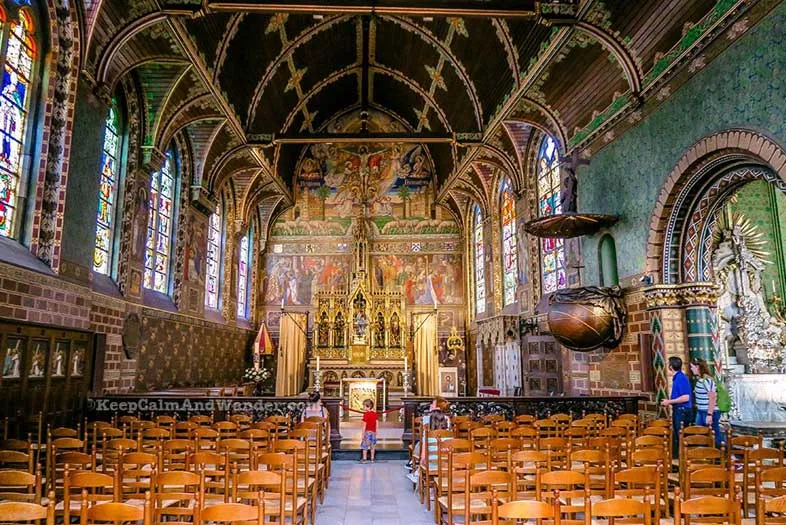
In 1134, Thierry of Alsace decided to build a private double chapel next to the Oud Steen, the first residence of the Counts of Flanders, transformed today into the town hall of Bruges. Thierry went on crusade a second time in 1147 during the Second Crusade. According to the tradition, Thierry of Alsace returned to his capital Bruges on April 7, 1150, with the relic of the Precious Blood. During the first half of the 13th century, the name of the upper chapel was changed to the Chapel of the Holy Blood.
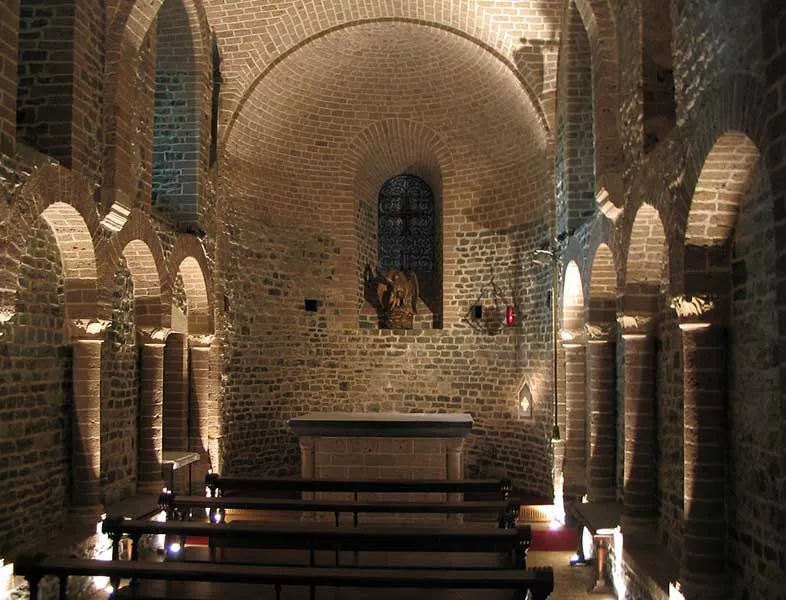
The Lower Basilica of Saint Basil
The Basilica of Saint Basil is the only fully preserved Romanesque church building in the province of West Flanders. Founded in the 12th century by Count Diederik van de Elzas (1128-1168), it was placed under the protection of Saint Basil the Great, a famous Greek Doctor of the Church from the 4th century, whose relics were brought to Bruges by Count Robrecht II from Caesarea transferred.
The floor plan depicts an elongated space, divided into a central aisle and two narrow side aisles. The choir, in line with the nave, is closed with a semi-circular apse. In the right aisle is a wooden polychrome statue of Our Lady and Child, a Sedes Sapientiae dating from the 1300s. In the southern annex, the arched field above a former entrance gate is decorated by the Romanesque tympanum depicting the Baptism of Saint Basil.
Two other remarkable sculptures, the Pieta (Mary with Jesus’ dead body on her lap) and the Ecce Homo (Christ on the cold stone), both date from 1900. The statues enjoy great popular devotion and are displayed annually in the Procession of the Holy Blood carried.
To the left of the choir is the small Sint-Ivokapel, which was the place of worship of Bruges jurists under the Ancien Regime, and was originally dedicated to Sint-Laurentius. The black marble altarpiece is said to have been executed after drawings by Lanceloot Blondeel.
The Basilica of St. Basil, also called to the Holy Blood, functioned as the comital chapel of both Diederik van de Elzas and his son Philip, who resided in the adjacent Steen, which has now disappeared. The lower chapel was conceived as the substructure of the upper chapel, which was originally built in Romanesque style, but underwent many radical changes over the centuries. Both chapels were elevated to basilica status in 1923.
The richly decorated De Steeghere stairwell that leads to the upper basilica was built in 1533 in Renaissance style with late Gothic decorations. However, the current building dates from the 19th century after the original was completely destroyed during the French Revolution.
The gilded bronze statues on the facade represent Archduchess Isabella, Mary of Burgundy, Diederik and Philip of Elzas. In the half medallions we recognize Archduke Albrecht, Maximilian of Austria, Margaret of York and Sybilla of Anjou, wife of Diederik and mother of Philip.

The Upper Basilica
The Gothic upper basilica dates from the end of the 15th century. Only the three round arches that give access to the side chapel of the Holy Cross are a remnant of the original Romanesque upper chapel. The stained glass windows in the choir date from 1845 and represent in chronological order the monarchs who ruled the county of Flanders from Philip the Bold, Duke of Burgundy (1342-1404), to Maria-Theresa, Empress of Austria (1717-1780).
On either side of the main altar are the decorations typical of a basilica: the tintinnabulum or small bell in a decorated frame, and the conopeum or half-down sunshade in yellow and red silk. The original pulpit was made by sculptor Hendrik Pulinckx in 1728 in the shape of a globe: God’s word, which is proclaimed from the pulpit, must reach the whole world.
The large wall painting behind the neo-Gothic main altar was completed in 1905. The upper part depicts the mystery of the Cross, where Christ shed his blood. In the background, on the left, Bethlehem, his birthplace, and on the right, Jerusalem, where he died. The lower scene shows how Diederik van de Elzas receives the Holy Blood Relic from the hands of the Patriarch of Jerusalem and how he, having arrived in Bruges and with Countess Sybilla next to him, entrusts the relic to the chaplain.
The small altar set up in the center of the choir is decorated with an alabaster relief statue of the Last Supper, dating from the early 17th century. Between the choir and nave is an oak communion rail (17th century) decorated with foliage and sculpted busts of saints.
The altar in white marble in the Chapel of the Holy Cross is the work (1751) of Hendrik Pullinx. The two kneeling angels are by Pieter Pepers and the silver tabernacle by the Bruges goldsmith Ryelandt. To the right of the altar is a painting on canvas Deposition from the Cross (1649) attributed to Jacob van Oost and inspired by Caravaggio.
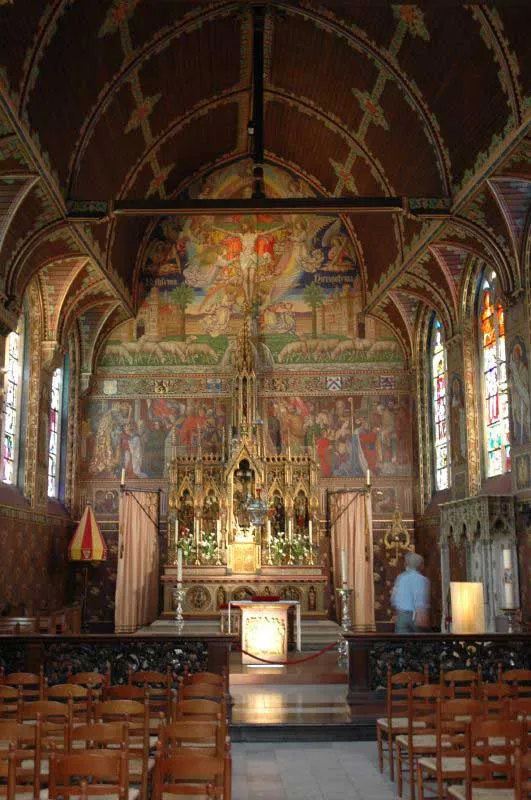
Chapel of the Holy Blood
Architectural Styles: Romanesque Architecture, Gothic Revival Architecture.
Originally built in Romanesque style like the St Basil chapel, the upper chapel was transformed in Gothic Style at the end of the 15th century and again in 1823. Only the curved arches giving access to the side chapel of the Holy Cross remain from the original Romanesque chapel.
The monumental staircase, commonly named De Steegheere, which leads to the upper chapel, was built in from 1529 to 1533 in late Gothic and Renaissance style according to the drawings of Flemish painter and architect William Aerts, ornamented on the outside with sculpted statues.
The aftermath of the French Revolution left the staircase badly damaged and it was decided in 1832 to move it 4 metres (13 ft) backwards and to rebuild it after removing the remaining ruins of the Oud Steen. The gilded bronze statues represent Archduchess Isabelle of Burgundy, Mary of Burgundy, Thierry of Alsace and Philip of Alsace and, in the medallions, the Archdukes of Austria Albert VII and Maximilian III, Margaret of York and Sibylla of Anjou, wife of Thierry and daughter of King Fulk of Jerusalem.
During the 19th century, successive renovation campaigns gave to the chapel its final Gothic Revival aspect, with its characteristic mural decorations. The stained-glass windows in the choir date from 1845 and represent the sovereigns who reigned over the County of Flanders from Philip the Bold, duke of Burgundy, till Archduchess Maria Theresa of Austria, Holy Roman empress.
The following architects and artists took part in these neo-Gothic renovations of the Chapel of the Holy Blood:
- Jean-Baptiste Bethune
- Louis Delacenserie
- Thomas Harper King
- William Curtis Brangwyn, father of Frank Brangwyn
- Charles De Wulf, architect of the city of Bruges and winner of the Prix de Rome in 1887
The pulpit in the form of a globe was made in 1728 by Henry Pulinckx, inspired by its evangelical purpose: “Go into all the world and preach the gospel” Mark 16:15.
The large wall-painting behind the high altar was realized in 1905. In the upper part, the Mystery of the Cross depicts Christ shedding his blood, with, in the background, the towns of Bethlehem, where Christ was born, and Jerusalem where he died. The lower part depicts the transport of the relic from Jerusalem to Bruges: on the left, Thierry of Alsace receives the relic from Baldwin III of Jerusalem, King of Jerusalem; on the right, kneeling besides Countess Sibylla of Anjou, he hands over the relic to the chaplain.
The high altar used today for the Eucharist is decorated with a relief in alabaster from the beginning of the 17th century depicting the Last Supper. Typical attributes of a basilica, the tintinnabulum, the small processional bell, and the Umbraculum, the sunscreen in the form of a parasol in yellow and red silk, are displayed next to the high altar.
Laurent Delvaux completed in 1751 the white marble altar in Baroque style for the relic side chapel. The two adoring angels were made by Peter Pepers. The relic is kept in a magnificent silver tabernacle made by local silversmith François Ryelandt (1709–1774), representing the “Lamb of Christ”. To the right of the altar, the painting of Jacob van Oost depicts the descent from the Cross. The relic is shown to the public every Friday and every day two weeks before Ascension Day.
Relic of the Precious Blood
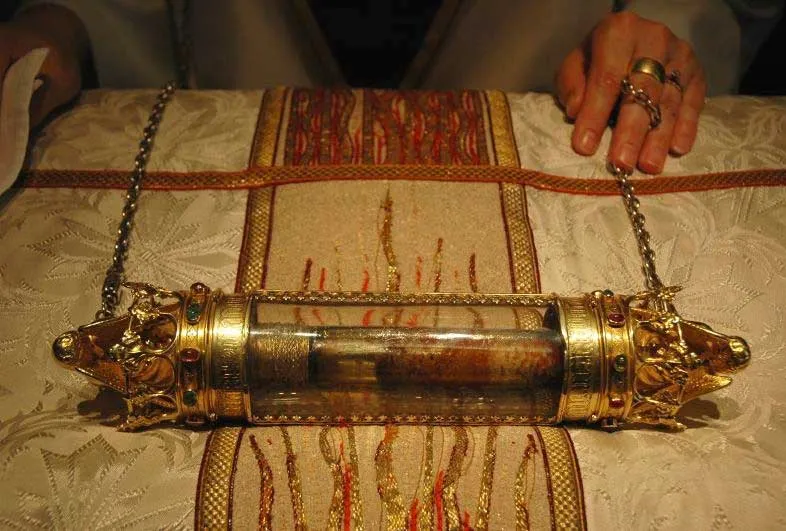
The basilica is best known as the repository of a venerated phial said to contain a cloth with blood of Jesus Christ, brought to the city by Thierry of Alsace after the 12th century Second Crusade. Although the Bible never mentions Christ’s blood being preserved, Acts of Pilate – one of the apocryphal gospels – relates that Joseph of Arimathea preserved the Precious Blood after he had washed the dead body of Christ; legends of Joseph were popular in the early thirteenth century, connected also with the emerging mythology of the Holy Grail.
Popular legend claims that the phial was taken to Bruges during the Second Crusade of CE 1147–1149, by Thierry of Alsace, who returned from Jerusalem with the relic of the Holy Blood presented to him by his brother-in-law Baldwin III of Jerusalem, as the reward of his great services.
Recent research found no evidence of the presence of the relic in Bruges before the 1250s. In all likelihood, the relic originated from the 1204 sack of Constantinople by the army of the Count of Flanders, Baldwin IX during the Fourth Crusade. Ever since, the phial has played a big part in the religious life of the city.
Pope Clement V issued a papal bull in 1310 granting indulgences to pilgrims who visited the chapel to view the relic; the blood was supposed to liquefy weekly at noon on Fridays; the miracle apparently ceased the same year, though a recurrence was alleged in 1388. There is no definitive evidence for or against the authenticity of the relic.
Modern examination has shown that the phial, made of rock crystal and dating back to the 11th or 12th century, was a Byzantine perfume bottle made in the area of Constantinople. Its neck is wound with gold thread and its stopper is sealed with red wax. The phial is encased in a glass-fronted gold cylinder closed at each end by coronets decorated with angels.
Procession of the Holy Blood
The reliquary used during the procession is displayed in the Basilica Museum. The shrine was made in 1617 in Bruges by goldsmith Jan Crabbe from some 30 kilograms of gold and silver and more than 100 precious stones. It consists of a gem-encrusted hexagonal case topped by golden statues representing Jesus Christ, the Virgin Mary, St. Donatian and St. Basil the Great.
The Noble Brotherhood of the Holy Blood
The Noble Confrérie of the Holy Blood was founded shortly after 1400. Its purpose is to preserve the relic and to promote its veneration.
She organizes, among other things, the annual procession. The 31 members must live in Bruges and, as an old document puts it, “be men of honour”.
The provost (chairman) can be recognized by the rich necklace. On major ceremonies, the confreres wear a black silk tabard embroidered with the pelican feeding its young with its blood.

Jeu du Saint Sang
Jeu du Saint Sang is a Belgian passion play, performed in Bruges. It was first published in 1938, and translated into French by Émile Schwartz.
In Popular Culture
In the 2008 movie In Bruges, Brendan Gleeson as Ken pays a visit to the relic of the Holy Blood. However, the privately owned Church of Jerusalem built in the 15th century according to the plans of the Holy Sepulchre in Jerusalem was used instead of the Basilica.
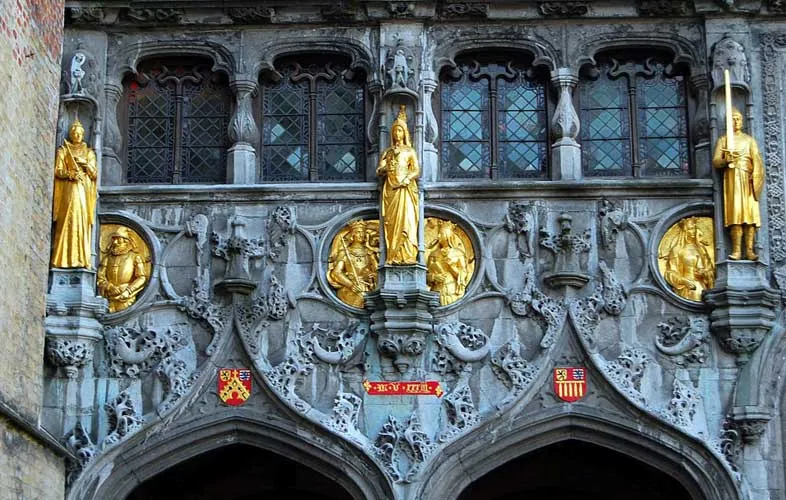
Feast Day - 18th May
Every year on Ascension Day (18th May), the Procession of the Holy Blood passes through the historic city centre of Bruges.
Mass Time
Mondays
Every Days
Church Visiting Time
Contact Info
Basilica of the Holy Blood,
13, Burg, 8000, Brugge, Belgium
Phone No.
Tel : +32 50 33 67 92
Accommodations
How to reach the Basilica
Brussels Airport (BRU) is an international airport is located in northeast of Brussels, Belgium is the nearby Airport to the Basilica.
Brugge Transit Stop in Bruges, Belgium is the nearby Train Station to the Basilica.








